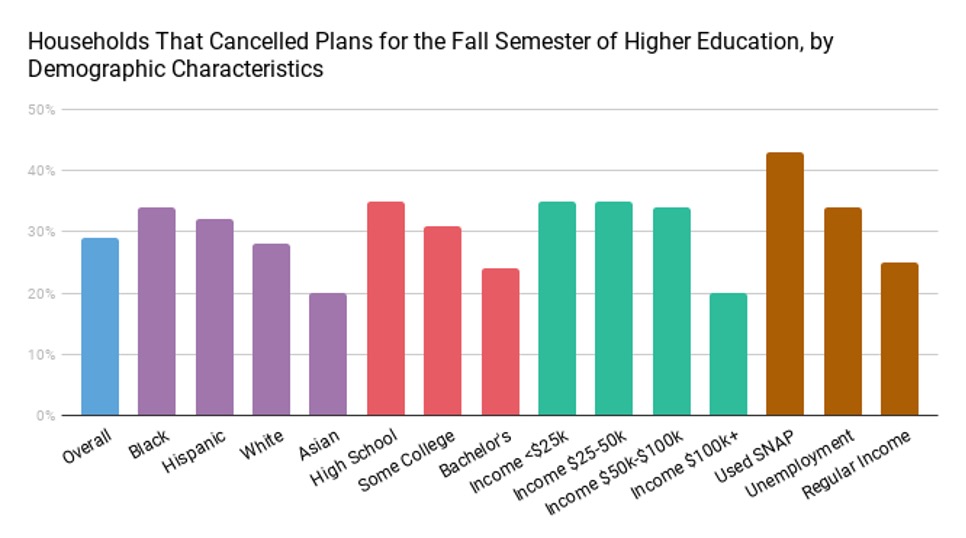Source: McCann, C. (2020, September 18). New federal survey data show the pandemic has hit would-be college students hard. New America analysis of data from the U.S. Census Bureau’s Household Plus Survey.
By Alexis Dancer
Since March of last year many students haven’t been able to go to school in person. It wasn’t until recently that Elementary and Middle Schools started allowing more than one or two grade levels to attend with schedules to keep them separated. “..students across the U.S. are ready to go back to school with 76% of those polled saying they would return to campus if they have the option and 66% saying they would attend in-person classes.” According to Dawn Geske. Working while going to school is difficult and many students do it, but trying to self-motivate while only relying on your laptop or having to miss zoom lectures because of work and the unspecific times set for those makes things a lot more difficult. On top of these struggles with focusing, many also struggle with making ends meet during these hard times the country is going through and with tuition rates remaining the same during that, many have stopped going to school.
In a poll of 50 students, 48 of them agreed tuition should be dropped at this time, while only 2 said no. Six of those students from different colleges ranging from California, Oregon, and Washington, said that they think it should be dropped due to the lack of resources and buildings being used. They think that the charges included in student tuition for things like these and labs are unnecessary at this time and that the engagement with the professors and schoolwork being taught to them is not the same. It’s turned into more of a self-learning thing. One student, Bailey Gallardo from Western Oregon University said “I’m paying a lab fee yet the labs I do in my living room. I also understand buildings need to be up-kept but we can’t even go in them.” Another student, Tanna Marshall, who is a second year at Skagit Valley College said, “For me I don’t see why I am paying the same amount to receive less education, if I wanted to do online I would have my degree by now, but trying to learn on your own like that is difficult.”
This is especially relevant to science and nursing majors trying to understand terminology and find time to practice without having the designated class time they’re use to. Another controversy many students have is the engagement levels of their professors at this time. Some professors have zoom lectures they upload, but others don’t and expect you to rely heavily on your textbooks and if they have office hours you better hope you don’t work during that time. Students are losing out on the human interaction that comes with learning in class.
When will these extra fees for classes start to drop though? BrokeScholar and CollegeBoard news sites have been looking at the raising rates of tuition for years and concluded “For public two-year institutions, public four-year institutions and private nonprofit four-year institutions, the average cost of college tuition and fees has increased by more than 200% for all of them.” For wanting to educate the future generations, why is the Government making it cost so much for them to receive it? Especially when most feel like they’re currently being taken advantage of with their money while receiving half of the education and some professors are getting other jobs, making it so they aren’t as focused on helping their students. The College of Desert is looking for new ways to “help bring a sense of community to your online course.” In hopes of avoiding those feeling some students are having, which create thoughts of dropping out or pushing back graduating until they can do the courses in person.
Some faculty at Skagit Valley College are doing what they can to assist with lowering costs for students as well. John Drummond, a professor at the college, said “If colleges are able to reduce costs for students though, they definitely should. If cutting tuition is not a possibility I think institutions and instructors can do other things to help students save money.” He has made it so his class requirements involve open textbooks and math programs that are free to students, saving them “around $100” according to Drummond. Colleges could also look into giving out rental laptops and Wi-Fi hotspots if accessible to reduce a large bill for students. Without addressing this problem and trying to find an equal middle where colleges can still afford to run without charging the students extra unnecessary fees for this time, enrollment rates are going to continue dropping. Nobody knows how much longer people are going to have to live and learn like this, that’s enough stress. With enrollment rates dropping as is, colleges are losing funds and without students being able to afford tuition, there needs to be a middle ground during the pandemic where both of the issues can be resolved.






